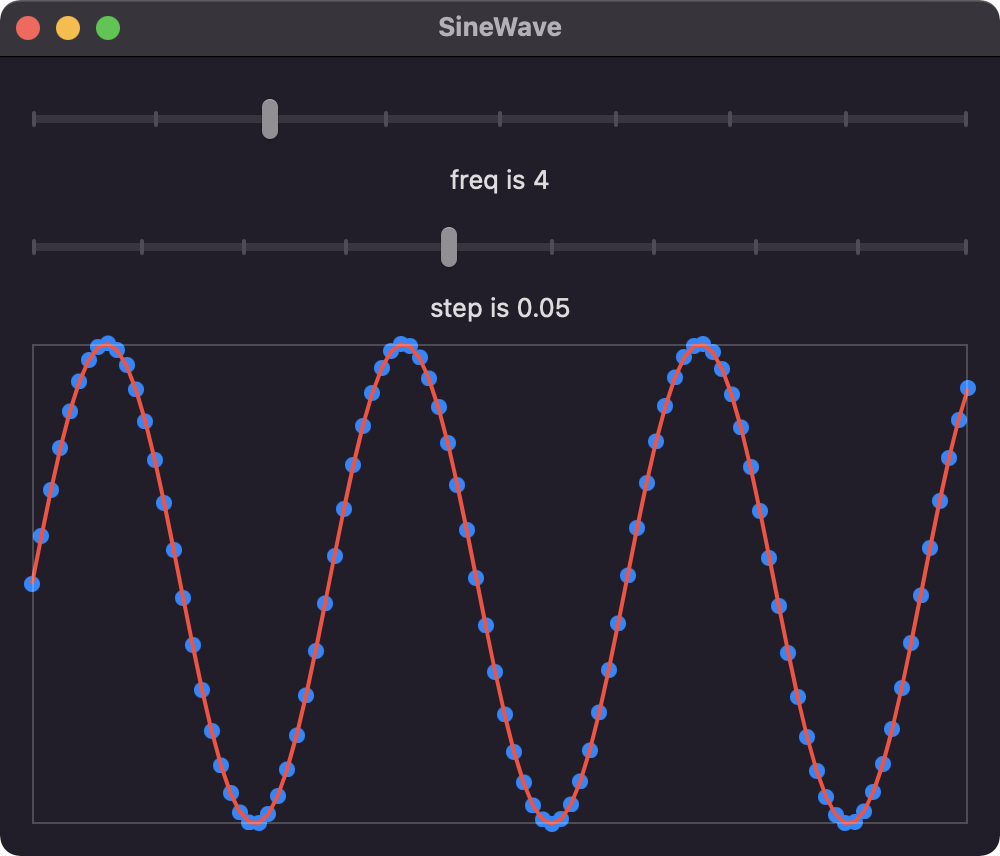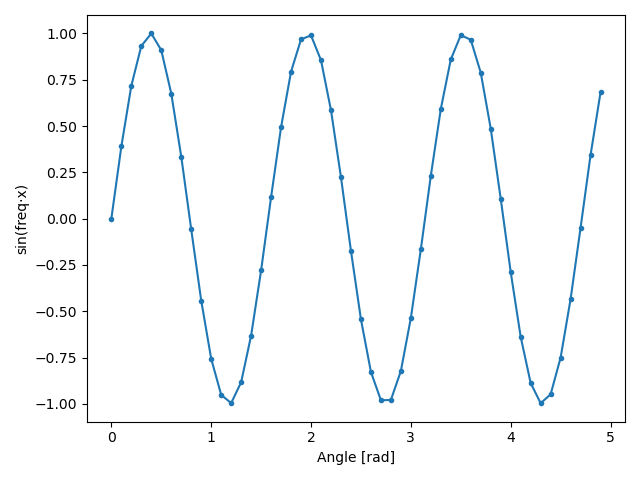Sine Wave in SwiftUI
Written on February 4, 2023
To draw a sine wave, create a shape that draws a line using x and y values. The values must be converted to the proper points within the view's frame. Markers represent points on the drawn line.

import SwiftUI
struct MarkersView: View {
let xValues: [Double]
let yValues: [Double]
var body: some View {
GeometryReader { geom in
let xMin = xValues.min() ?? 0.0
let xMax = xValues.max() ?? 1.0
let yMin = yValues.min() ?? 0.0
let yMax = yValues.max() ?? 1.0
ForEach(0..<yValues.count, id: \.self) { i in
Circle()
.fill(.blue)
.frame(width: 8)
.position(
x: ((xValues[i] - xMin) * (geom.size.width)) / (xMax - xMin),
y: geom.size.height - ((yValues[i] - yMin) * (geom.size.height)) / (yMax - yMin)
)
}
}
}
}
struct LineShape: Shape {
let xValues: [Double]
let yValues: [Double]
func path(in rect: CGRect) -> Path {
let xMin = xValues.min() ?? 0.0
let xMax = xValues.max() ?? 1.0
let yMin = yValues.min() ?? 0.0
let yMax = yValues.max() ?? 1.0
// Scale values to CGPoints based on formula at https://en.wikipedia.org/wiki/Normalization_(statistics)
// X' = a + (X - Xmin)(b - a) / (Xmax - Xmin)
let pts = zip(xValues, yValues).map { (x: Double, y: Double) -> CGPoint in
let xn = ((x - xMin) * (rect.width)) / (xMax - xMin)
let yn = rect.height - ((y - yMin) * (rect.height)) / (yMax - yMin)
return CGPoint(x: xn, y: yn)
}
var path = Path()
path.move(to: pts[0])
for i in 1..<pts.count {
path.addLine(to: pts[i])
}
return path
}
}
struct SineView: View {
@ObservedObject var data: Data
var body: some View {
ZStack {
MarkersView(xValues: data.x, yValues: data.y)
LineShape(xValues: data.x, yValues: data.y)
.stroke(.red, lineWidth: 2.0)
.border(.white.opacity(0.2))
}
}
}
The sine wave view is updated by adjusting the frequency and step values.
import SwiftUI
class Data: ObservableObject {
@Published var freq: Double = 4
@Published var step: Double = 0.05
var x: [Double] {
Array(stride(from: 0, to: 5, by: step))
}
var y: [Double] {
x.map { sin(freq * $0) }
}
}
struct ContentView: View {
@StateObject private var data = Data()
var body: some View {
VStack {
Slider(value: $data.freq, in: 2...10, step: 1.0)
Text("freq is \(data.freq, specifier: "%.0f")")
Slider(value: $data.step, in: 0.01...0.1, step: 0.01)
Text("step is \(data.step, specifier: "%.2f")")
SineView(data: data)
}
.padding()
.frame(minWidth: 500, minHeight: 400)
}
}
The Python example below provides a comparison to the Swift version. The Matplotlib Python package is used to create the plot.

import numpy as np
import matplotlib.pyplot as plt
freq = 4
step = 0.1
x = np.arange(0, 5, step)
y = np.sin(freq * x)
_, ax = plt.subplots(tight_layout=True)
ax.plot(x, y, marker='.')
ax.set_xlabel('Angle [rad]')
ax.set_ylabel('sin(freq⋅x)')
plt.show()
Gavin Wiggins © 2025
Made on a Mac with Genja. Hosted on GitHub Pages.